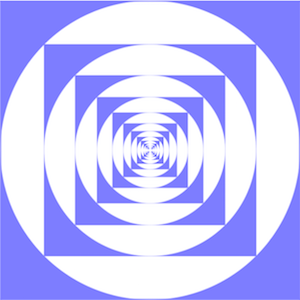Simple fractal area

The figure shows an infinite sequence of inscribed circles and squares where the largest square has a side of 2 units.
If the area shaded in blue can be expressed as A − B π , find A + B .
The answer is 10.
This section requires Javascript.
You are seeing this because something didn't load right. We suggest you, (a) try
refreshing the page, (b) enabling javascript if it is disabled on your browser and,
finally, (c)
loading the
non-javascript version of this page
. We're sorry about the hassle.
2 solutions
A 1 A 2 L 1 L 2 A 2 A 2 A 2 A 1 A 1 − ( 4 − π ) A 1 A 1 − ( 4 − π ) A 1 = the blue shaded area under the biggest square = the blue shaded area under the second square = the side length of the biggest square = 2 = the side length of the second square = 2 = A 1 − the area of the largest four blue corners = A 1 − ( 4 − π ) = ( L 2 L 1 ) 2 = ( 2 2 ) 2 = 2 ⇒ A 1 = 8 − 2 π
The four largest blue corners have an area which is the result of subtracting the areas of the largest square and the largest circle: 2 2 − π ⋅ 1 2 = 4 − π . The next square in the sequence has an area which is one-half of the largest square since its side is diminished by a factor of 2 2 . The area of its four blue corners is then ( 2 2 ) 2 = 2 1 the area of the four largest, and this ratio is the same for every step in the sequence.
The total area is the sum of the infinite terms of a geometric progression of ratio r = 2 1 and a 1 = 4 − π :
S ∞ = 1 − r a 1 = 1 − 2 1 4 − π = 8 − 2 π
So the answer is A = 8 , B = 2 and A + B = 1 0